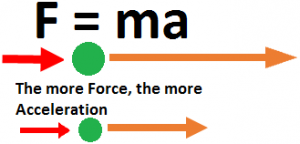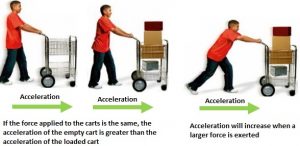Newton’s first law explains what happens to an object when no force acts on it, it either remains at rest or moves in a straight line with constant speed.
Newton’s Second Law answers the question of what happens to an object when one or more forces act on it.
Newton’s second law of motion establishes a relation between the net force acting on a baby and the net acceleration of the body. Second law states that the net acceleration of a body is directly proportional to the net force acting on the body. Also, the net acceleration is inversely proportional to the mass of the body.
a α F
\(a\,\,\,\,\propto \,\,\,\,\frac{1}{m}\)
\(a\,\,\,=\,\,\,\frac{F}{m}\) It means, that the more the net force acting on a body, the greater would be its acceleration. And the more the mass of the body, the less would be the acceleration. In other words, if the two objects, one heavier than the other, are pushed by same force, the acceleration produced in the heavier object would be less. The heavier is the object, the more force is required to alter its velocity. Again, if two forces, different in magnitude are applied to the same object, the force which is greater in magnitude will create more acceleration.
It means, that the more the net force acting on a body, the greater would be its acceleration. And the more the mass of the body, the less would be the acceleration. In other words, if the two objects, one heavier than the other, are pushed by same force, the acceleration produced in the heavier object would be less. The heavier is the object, the more force is required to alter its velocity. Again, if two forces, different in magnitude are applied to the same object, the force which is greater in magnitude will create more acceleration.
The net acceleration of a body is equal to the net force acting on it divided by the mass of the body. Remember, if there are multiple forces acting on a body, we have to take the resultant force in order to calculate the net acceleration. The direction of acceleration will be the same as the direction of force.
Acceleration depending on mass, suppose that your pushing an empty cart, you have to exert only a small force on the cart to accelerate it. But, if the same amount of forced will not accelerate a full cart as on an empty cart. Acceleration depending on force, suppose you give a cart a hard push, the cart will moving faster than if you have it only a soft push. So an object’s acceleration increases as the force on the object increases. An object’s acceleration decreases as the force on the object decreases. Examples of Newton’s second Law in Everyday Life: This law of Newton applies to real life, being one of the laws of physics that impacts most in our daily lives:
Examples of Newton’s second Law in Everyday Life: This law of Newton applies to real life, being one of the laws of physics that impacts most in our daily lives:
- Kicking a ball: When we kick a ball, we exert force in a specific direction, which is the direction in which it will travel.
In addition, the stronger that ball is kicked, the stronger the force we put on it and the further away it will go.
- Push a car: For example, pushing a supermarket cart with twice as much force produces twice as much acceleration.
- Two people walking together: The same reasoning above can be applied to any moving object. For example, two people walking together, but one of them has a lower weight than the other, although they walk with the same amount of force, who weighs less will go faster because their acceleration is certainly greater.
- Playing golf: In a golf game, the acceleration of the ball is directly proportional to the force applied to the club and inversely proportional to its mass. In the way influences the force of the air that can cause a small change in its direction.
- Capture the ball by hand: Professional athletes move their hands back once they catch the ball as it provides the ball more time to lose its speed, and in turn apply less force on its part.
How to find the Newton’s Second Law of Motion:
Example: A 1.50 kg bucket of water is tied by a rope and whirled in a circle with a radius of 1m. At the top of the circular loop, the speed of the bucket is 4 m/sec. determine the acceleration, the net force and the individual forces values when the bucket is at the top of the circular loop?
Solution:
Fgrav = m x g = 1.5 x 9.8 = 14.7 N
\(a\,=\,\frac{{{V}^{2}}}{R}\,=\,\frac{(4\times {{F}_{grav}})}{1}\,=\,16\,m/{{\sec }^{2}}\)
Fnet = Fgrav + Ftens
Ftens = Fnet – Fgrav
Fnet = 24 – 14.7 = 9.3 N
